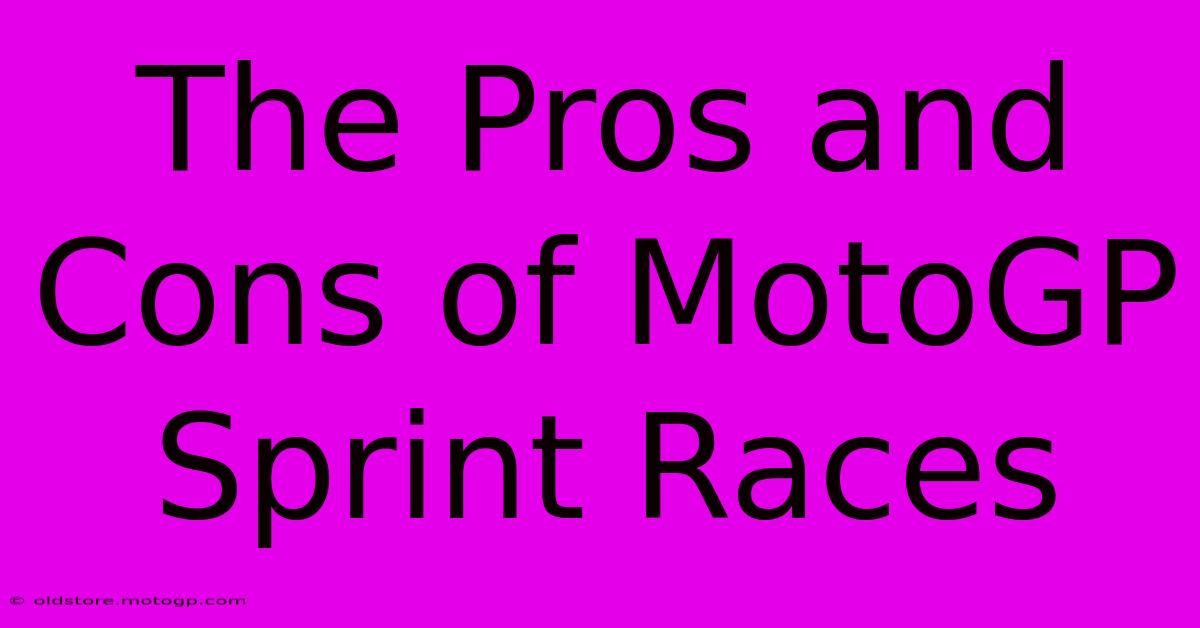The Pros And Cons Of MotoGP Sprint Races

Table of Contents
The Pros and Cons of MotoGP Sprint Races: A Deep Dive
MotoGP's introduction of sprint races has been a hot topic, sparking passionate debate among fans and pundits alike. This format change, adding a shorter, second race on each Grand Prix weekend, aims to boost excitement and engagement. But is it truly a success? Let's delve into the pros and cons of this thrilling addition to the world of motorcycle racing.
The Pros: More Bang for Your Buck
The arguments in favor of sprint races are compelling, focusing largely on increased entertainment value and broader fan engagement.
More Action, More Excitement
- Double the racing: The most obvious benefit is simply more racing. Fans get twice the on-track action for the price of one race ticket or viewing session. This is a significant draw for viewers and attendees alike.
- Increased Stakes: Sprint races introduce a new element of competition. While the main race still holds the most points, a good performance in the sprint can significantly impact the overall weekend strategy and grid positioning for Sunday's main event. This adds another layer of tactical complexity.
- Improved Showmanship: The shorter race format can encourage more aggressive riding and overtaking opportunities, leading to closer racing and more dramatic finishes. This is a recipe for generating excitement and viral moments on social media.
- Enhanced Viewer Engagement: The shorter duration makes the sprint races more accessible to viewers with less time commitments. This can attract new fans who might be hesitant to commit to the length of a full MotoGP race.
Financial Benefits for MotoGP
- Increased Sponsorship Opportunities: The addition of a second race provides more opportunities for sponsorship activations and brand integration. This translates to increased revenue for the sport and teams.
- Greater Media Coverage: More races inherently translate to more media coverage, including television broadcasts, online streaming, and social media engagement. This wider exposure can help grow the MotoGP fanbase globally.
The Cons: A Price to Pay for Excitement?
Despite the many benefits, the sprint race format isn't without its detractors. Several potential downsides warrant careful consideration.
Increased Risk and Wear and Tear
- Higher Risk of Injury: More racing inevitably means a higher risk of crashes and injuries for the riders. The added pressure and intensity of two races in a weekend could lead to fatigued riders making more mistakes.
- Increased Wear and Tear on Bikes and Teams: The added workload on both machinery and team personnel can be substantial. The cost of repairs and maintenance increases, putting additional strain on team budgets.
- Tire Degradation: Running two races on the same weekend can exacerbate tire wear, potentially impacting race strategy and performance in both the sprint and the main Grand Prix.
Potential for Dilution of the Main Event
- Reduced Significance of the Main Race?: Some argue that the introduction of sprint races diminishes the prestige and importance of the main Sunday race. The focus might shift, making the headline event feel less special.
- Fatigue and Strategic Impacts: Riders might prioritize the sprint race, potentially leading to less aggressive racing in the main event due to fatigue or strategic considerations. This could lead to less exciting main races in certain instances.
- Impact on Qualifying: The importance of qualifying could potentially be lessened, as the sprint race now plays a significant role in determining grid positions for the main race.
Conclusion: A Balancing Act
The introduction of sprint races in MotoGP presents a complex picture with clear advantages and disadvantages. While they undoubtedly inject more excitement and broaden the appeal of the sport, concerns about rider safety, increased costs, and the potential dilution of the main race remain valid. Ultimately, the success of sprint races will hinge on MotoGP's ability to manage these challenges and strike a balance between delivering thrilling entertainment and ensuring the long-term health and sustainability of the sport. Only time will tell if the pros truly outweigh the cons.

Thank you for visiting our website wich cover about The Pros And Cons Of MotoGP Sprint Races. We hope the information provided has been useful to you. Feel free to contact us if you have any questions or need further assistance. See you next time and dont miss to bookmark.
Featured Posts
-
The Aero Debate Balancing Innovation And Tradition
Feb 20, 2025
-
Find Your Way Around Cota The Formula 1 Austin Map
Feb 20, 2025
-
Cota Open Track Days Challenge Yourself
Feb 20, 2025
-
Circuit Of The Americas Store Your Racing Style Destination
Feb 20, 2025
-
F1 Qualifying The Heart Stopping Race For Pole
Feb 20, 2025
